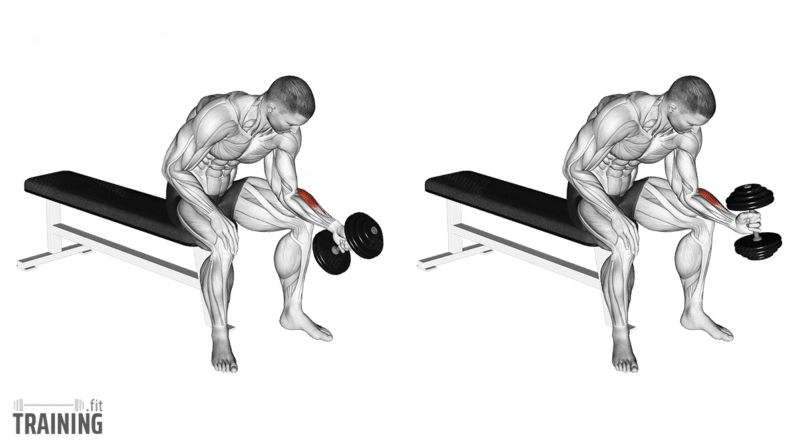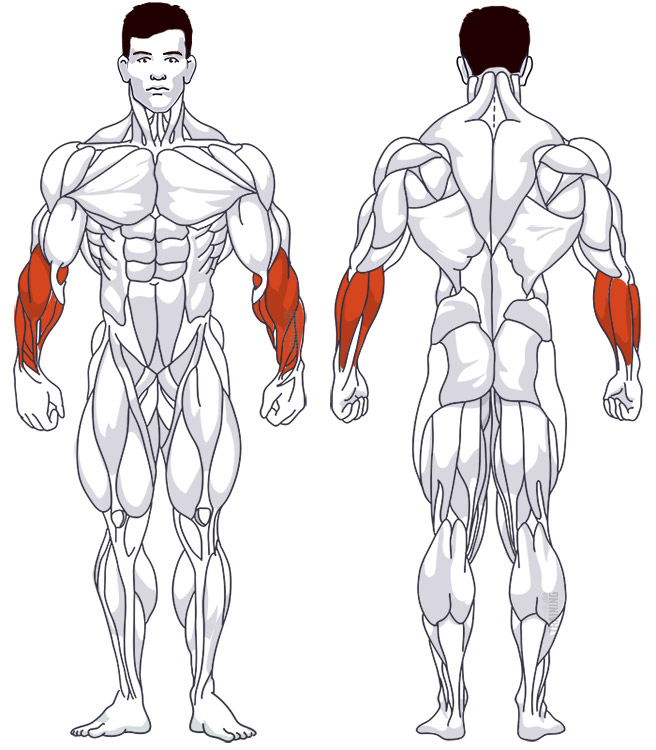Hammer Grip Wrist Curls
Isolation exercise, Free weightsOverview

Main muscles
- Forearm: Finger extensor
(Musculus extensor digitorum) - Forearm: Short radial hand extensor
(Musculus extensor carpi radialis brevis) - Forearm: Long radial hand extensor
(Musculus extensor carpi radialis longus) - Forearm: Brachioradialis
(Musculus brachioradialis)
Training plans
Hammer Grip Wrist Curls is a suitable substitute for similar exercises in or as a supplement to various training plans.
Hammer Grip Wrist Curls: Basics and alternatives

Involved main muscle groups:
Hammer Grip Wrist Curls
Hammer Grip Wrist Curls are one of many isolation exercises for training your forearms, with the main focus being the grip technique. The neutral grip is used for Hammer Grip Wrist Curls, which have a similar motion to other wrist curl exercises. During the exercise, you’ll hold the dumbbells firmly in your hands, and the forearm muscles are isolated by moving the wrists.
Hammer Grip Wrist Curls are an alternative variation of the classic wrist curls with dumbbells in underhand grip. Other alternative variations include wrist curls with a barbell or in overhand grip. If you don’t have dumbbells or barbells, you can also train your forearms at home with fitness bands.
Bicep exercises and pull-ups in overhand grip can also be considered another alternative, with the biceps being less activated and the forearms being more involved.
It’s important not to confuse Hammer Grip Wrist Curls with hammer curls, which focus on the upper arm, not the forearm.
Correct execution
Hammer Grip Wrist Curls can be performed in two different ways:
- You can sit on a flat bench, place your elbow on your thigh, and train your forearms one at a time.
- Or you can kneel in front of the flat bench and use it as support for your forearms, training both arms at the same time.
Performing the exercise simultaneously saves time but requires a flat bench or another suitable padded object. The alternating execution is more flexible in this regard but takes about twice as long to complete a set. Ultimately, it’s up to your personal preference how you perform the exercise. The video tutorial and textual instructions below show the simultaneous execution.
Video tutorial
Step-by-step instructions
Grab the dumbbells in your hands and kneel in front of the flat bench.
Lean your upper body forward and rest your forearms on the flat bench. The dumbbells should extend beyond the flat bench and remain movable through your wrists. Keep your back straight.
Hold the dumbbells in a neutral grip, i.e., grip them firmly, with the palms of your hands facing each other (back of your hands facing out).
Control the motion, lower your wrists and maintain tension. Don’t rest the weight on your wrists.
Curl your wrists upward and move the dumbbells up. Hold the position briefly, then lower the dumbbells.
Common mistakes
Always make sure to maintain tension in your forearm and not use your wrist to rest the weight. Your wrist should only be used for movement, not to release tension during high training volume. If you let go of the weight and fully extend your wrist, it can be not only painful but also lead to injuries.
Just like with bicep exercises, swinging can mess up your form during the exercise. Your forearm shouldn’t move during the workout. Don’t try to lift the weight by jerking your elbow.